How to Remove Yourself From Blacklist
Today, nearly everyone has received unwanted emails from bothersome salespeople offering yet another one-of-a-kind deal, creating a complete mess in the mail.
Such messages are called spam, and to protect ordinary people, mail services have invented various tools that send such letters to a special spam folder or reject them entirely and blacklist their senders.
If you are wondering how you got there and how to remove your IP from a blacklist, keep reading.
Here’s what this article discusses:
- What is Email Blacklisting?
- Different Kinds of Spam Blacklists:
- UCEPROTECTL1
- UCEPROTECTL3
- BARRACUDA
- ZapBL
- Abusix Mail Intelligence Blacklist
- Hostkarma Black
- Sender Score Reputation Network
- How Do I Get on These Blacklists?
- Remove Yourself From Blacklist
- Conclusion
What is Email Blacklisting?
Email blacklisting occurs when your IP or domain is added to specific lists of spammers.
But what do they call a spammer? If you send multiple promotional emails, is it fair to say you're a spammer?
It depends on the context and the nature of your promotional emails, spam is defined by the recipient. If you are sending unsolicited emails in bulk to recipients who have not permitted you to contact them, then yes, it would be fair to say that you are engaging in spamming.
However, if you send promotional emails to people who have explicitly opted in to receive communication from you (e.g., they have subscribed to your mailing list or provided consent), you are not a spammer. In this case, you are simply engaging in email marketing, a legitimate business practice.
Different Kinds of Spam Blacklists
Spam comes in many forms, from pesky commercial offers to elaborate schemes, for example, exploiting people's emotions for financial gain. While these schemes may have been a source of amusement, such as when a long-lost relative promised an inheritance, they have become more sophisticated, prompting many organizations to develop defenses against them.
As a result, protecting against unwanted and malicious emails has become increasingly important, requiring ongoing vigilance and adaptation to stay ahead of evolving tactics. Here are just a handful of the many Spam Blacklists that one might encounter.
The UCEPROTECTL1 Blacklist
UCEPROTECTL1 is a public DNS-based Blackhole that helps combat spam by maintaining a list of IP addresses that have been identified as sources of spam. Email administrators and service providers use this list to filter and block unwanted spam emails.
A key component of UCEProtect's spam detection methodology is the use of spam traps. These are email addresses specifically created to identify and monitor spam activities.
Spam traps are typically not used for regular email communication and are strategically placed throughout the internet to lure spammers into sending unsolicited emails to these addresses.
When a spammer sends an email to a spam trap, the originating IP address is logged and can be added to the UCEPROTECTL1. Email services can then use this list to block incoming emails from IP addresses flagged as spam sources.
- But at the same time, UCEPROTECTL1 has a somewhat ambiguous reputation due to criticism of mistakenly blacklisting innocent IPs and a paid service for immediately removing them from the list. Although UCEPROTECTL1 will automatically remove IPs from the blacklist after seven days, no one will return the time, let alone the money, if your business depends on email communications.
The UCEPROTECTL3 Blacklist
UCEPROTECTL1 supports three levels of blacklists, each with a different degree of protection against spam. The main difference between UCEPROTECTL1 and UCEPROTECTL3 is the scale and severity of the IP addresses they blacklist.
UCEPROTECTL1 This level targets individual IP addresses that have been caught spamming by a spam trap or that have been reported by third-party sources. This is the most basic and least aggressive level of protection.
UCEPROTECTL3 This level is more aggressive in its approach. Instead of just single IP addresses, UCEPROTECTL3 blacklists the whole range of IP addresses, thus trying to pressure network administrators to take action against spammers working in their networks.
Although this tactic has its consequences; for example, if there were innocent IP addresses in that IP range, they would be blacklisted. Also, not all network admins have enough resources to respond to all spammer activity.
The BARRACUDA Blacklist
Barracuda, as well as UCEProtect, is a well-known organization in spam prevention and email protection. Speaking of differences, Barracuda uses a more robust and complicated approach instead of focusing on blacklisting from spam traps and user referrals.
To begin with, Barracuda is a serious cybersecurity organization that provides data and network security services in addition to spam detectors. This experience helped to create a unique spam detection system:
Spam fingerprinting: This technique involves creating unique "fingerprints" or patterns of known spam messages. These fingerprints are then used to compare against incoming emails. If a match is found, the email is flagged as spam and blocked or quarantined accordingly.
Domain reputation: A domain's reputation is evaluated based on factors such as its age, its association with spamming activities, and the presence of any known malicious content.
IP reputation is evaluating an IP address's trustworthiness based on past activities. An example would be if the IP had any history of sending spam, phishing, or other malicious activities.
Barracuda maintains its proprietary databases for IP and domain reputation. These databases are built using data from its customers, sensors, and honeypots, which mimic a legitimate system or resource but are actually isolated and closely monitored to gain data about the spammers.
The Spamhaus Blacklist
Another notable blacklist highly regarded by email services is the Spamhaus blacklist. If your IP ends up on this list, you won't be able to send emails to leading providers like Google or Yahoo.
A distinctive feature of Spamhaus is the ROKSO database, which enables ISPs to examine even newly assigned IPs. In the past, scammers merely changed their IP addresses after being blocked and continued sending spam. However, ROKSO employs additional data about the domain, server, and content sent to ensure that spammers can't easily switch to new hosting and evade detection.
The Abusix Mail Intelligence Blacklist
Abusix Mail Intelligence Blacklist is a real-time database of IP addresses and domains known for sending spam, phishing emails, and distributing malware. Maintained by Abusix, a company specializing in threat intelligence and email security, the blacklist aims to protect businesses and individuals from email-borne threats.
The AMI Blacklist is created through a combination of automated and manual processes. Data is collected from various sources and then analyzed by Abusix's threat intelligence team to identify patterns of spam and malicious activities. Confirmed sources of malicious activities are added to the blacklist, while false positives are removed. The list is updated continuously in real-time to maintain its accuracy and effectiveness.
The Hostkarma Black Blacklist
HostKarma, although less renowned than UCEPROTECT, operates on similar principles by maintaining databases of IP addresses associated with spam. Internet providers utilize these databases to identify and filter spam. Despite the dominance of major players like UCEPROTECT and Barracuda, smaller companies like HostKarma play a crucial role in detecting less prominent local IP ranges, contributing to better user spam protection.
The Sender Score Reputation Network
The quality of your email reputation determines whether your messages land in the recipient's inbox or spam folder.
Typically, all email reputations begin at the "newbie" stage. This means that it takes time to establish yourself as a trustworthy sender when you create a new email address. During this phase, your emails might accidentally land in spam folders, and you may need to ask recipients to mark your messages as "not spam" a few times. This action helps improve your reputation and gradually solidifies your standing among trusted senders.
As you embark on a new marketing campaign and the volume of emails increases, it's crucial to ensure that you're using approved techniques. Even if you're a well-known brand, a single mistake can damage your email reputation.
To check your email reputation, you can use this site: Senderscore.org.
How Do I Get on These Blacklists?
Nearly everyone who has encountered the issue of being blacklisted wonders why their IP was blacklisted in the first place, especially if they're confident they haven't done anything to warrant it.
In fact, there are multiple reasons. One of the most likely explanations is that a spammer virus may have breached your server and started sending out numerous emails.
There are several ways a virus like this could infiltrate your server:
- Your password may have been compromised online or was initially weak and hacked by password-sniffing bots. Thus, it's crucial to use a strong and unique password.
- If you haven't updated your drivers in a while, scammers might exploit a vulnerability in the outdated drivers to circumvent security measures.
- Your firewall settings weren't optimal so it couldn't detect and prevent the attack. For instance, a competent firewall can easily catch and block a password-cracking bot before it can brute-force various password combinations. A sign of a good firewall is when you get blocked after failing to enter your own password after a few attempts.
So, selecting your website hosting carefully is essential, as quality hosting ensures a high level of protection and maintenance for your site!
How to Confirm You are Blacklisted
Before attempting to remove from blacklist your IP, first confirm that it's actually blacklisted using this service: Mxtoolbox.com.
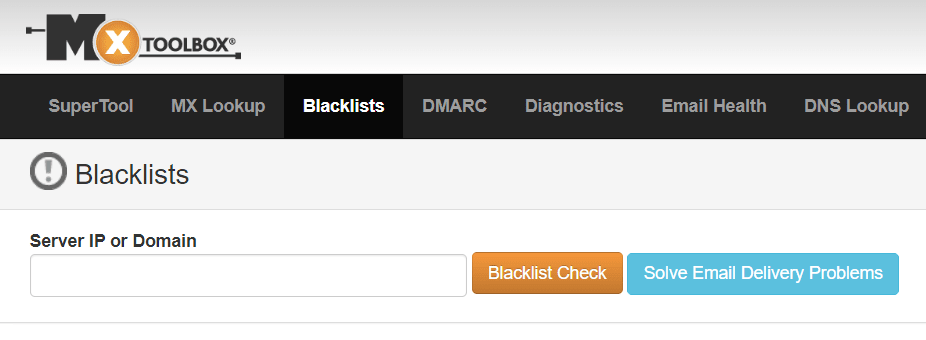
The MXtoolbox is a free tool that checks your IP or domain against over 100 blacklists. To begin, input your server IP address or simply enter your domain.
The following shows what a clean IP address should look like.
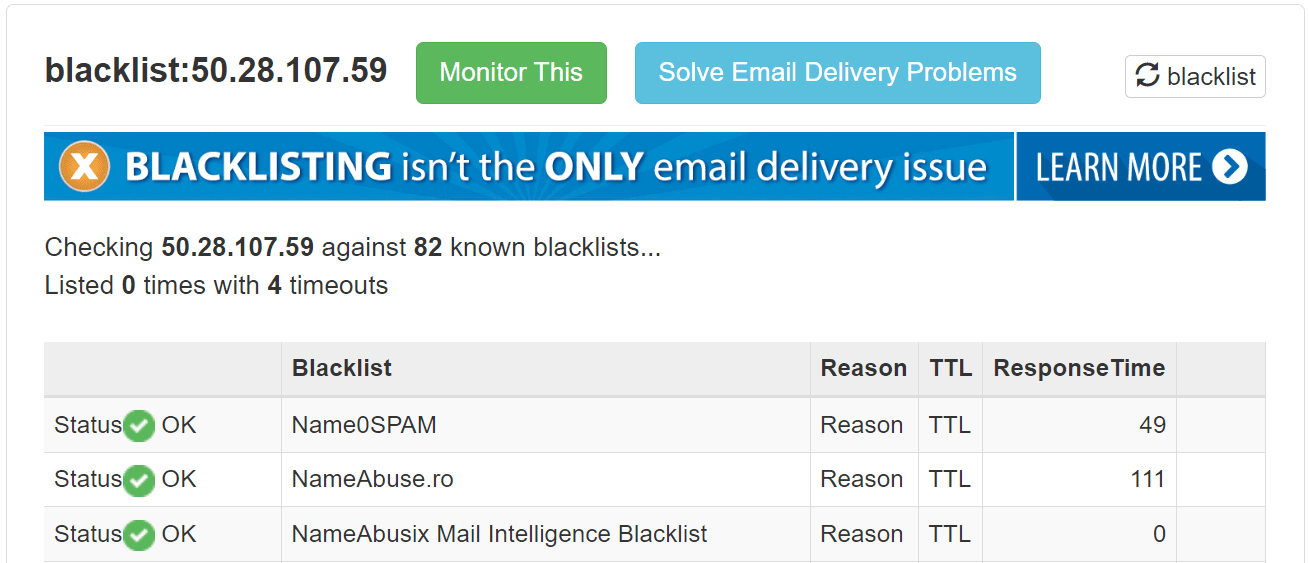
The IP successfully passed 82 known blacklists. However, let's examine the situation with a blacklisted IP.
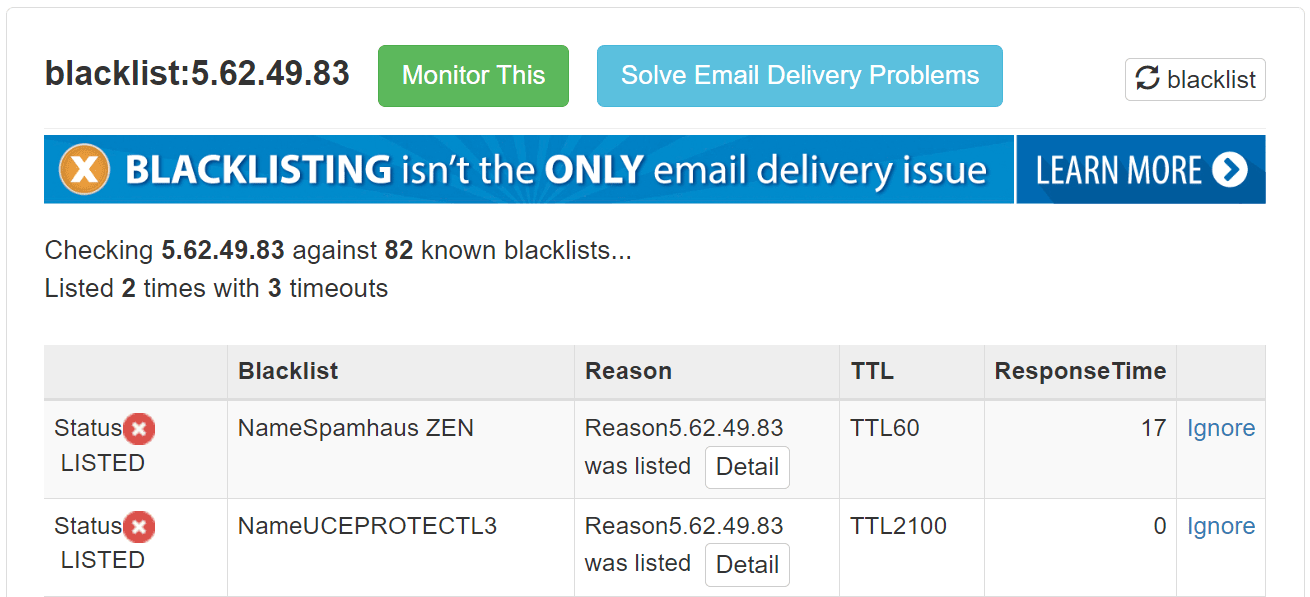
Submitting a removal request without checking may result in a denial if your IP was genuinely spamming. This would cause you to lose time and possibly face restrictions on resubmitting your request for a certain period.
Remove Yourself From Blacklist
Although numerous blacklists exist, they all operate on the same principle of removing your IP from the blacklist.
For instance, let's continue with the previous example where the IP 5.62.49.83 is found on two blacklists: Spamhaus and UCEPROTECTL3.
Step 1:
Find the website by searching the blacklist's name in a search engine, using the phrase blacklist removal to save time.
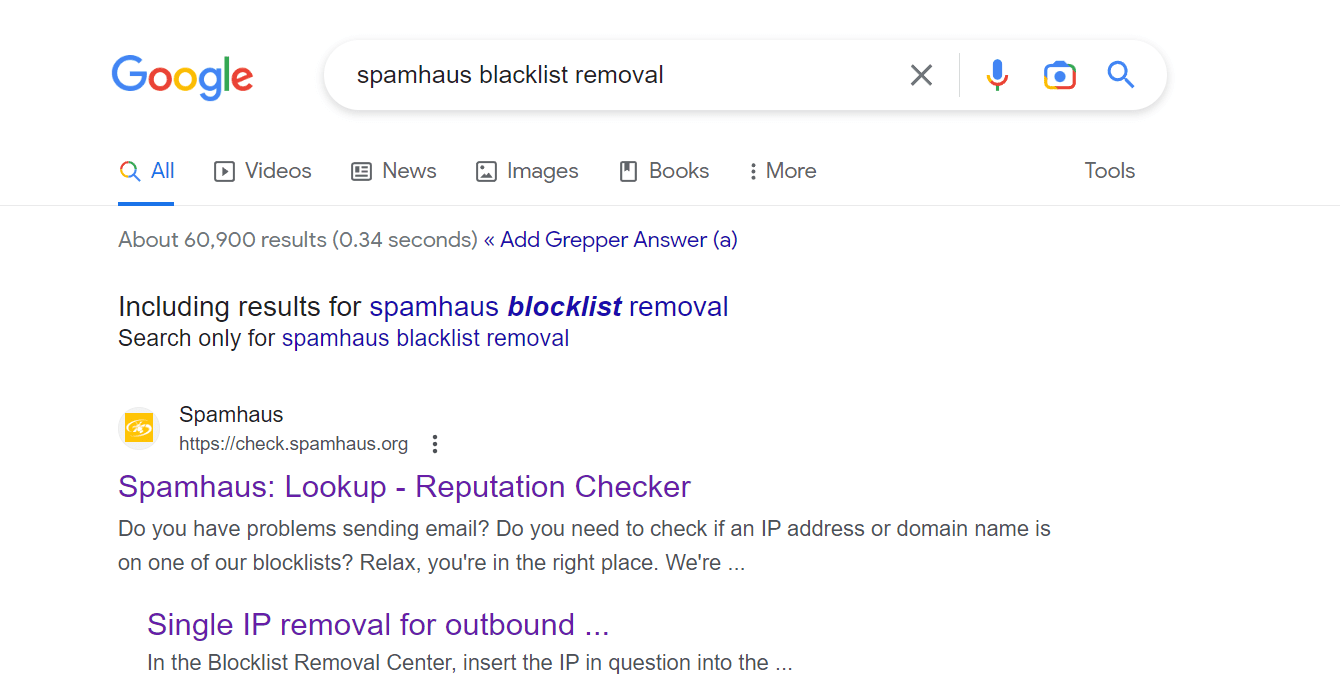
Stick to official websites, as they're the most effective and often the only way to remove from blacklist an IP. Look for links containing keywords like removal or similar terms. For this tutorial, use Single IP removal for outbound on the Spamhaus website.
If the official website does not appear on top, try searching how to remove yourself from blacklist or blacklist remove instead of blacklist removal.
Step 2:
Carefully read the information on the site and follow the instructions. Click the link for Blocklist Removal Center to begin the procedure.
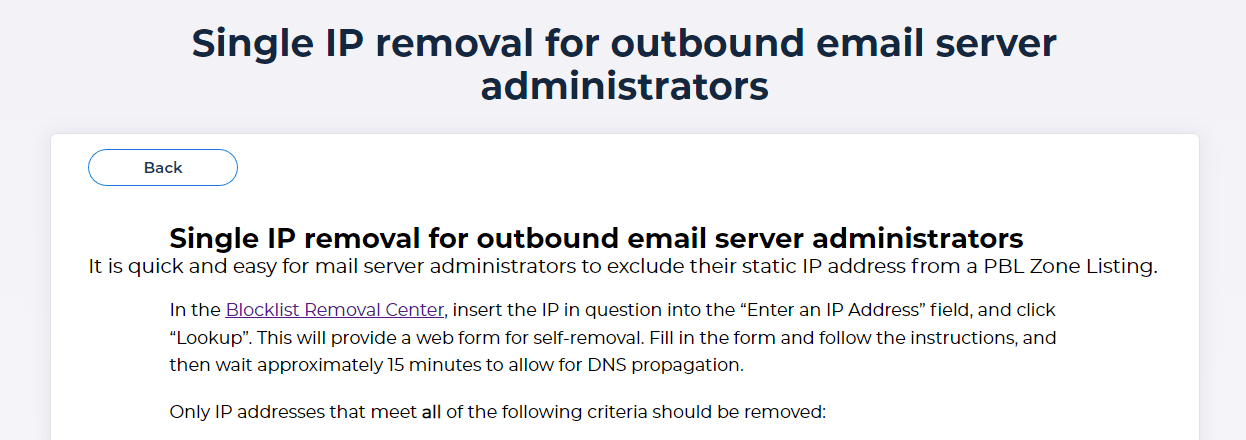
Enter your IP in the provided field on the next screen.
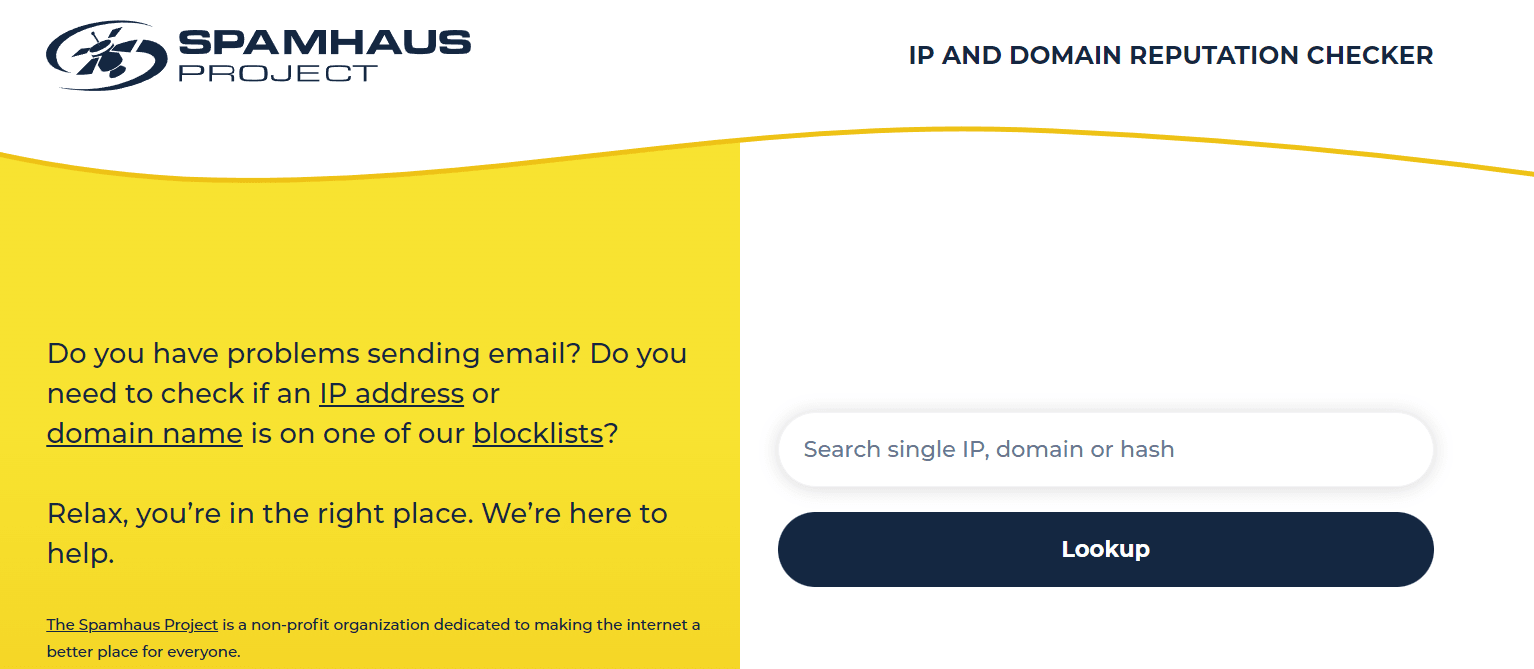
Following this, you'll see a message similar to the one on Mxtoolbox. Click Close to proceed.
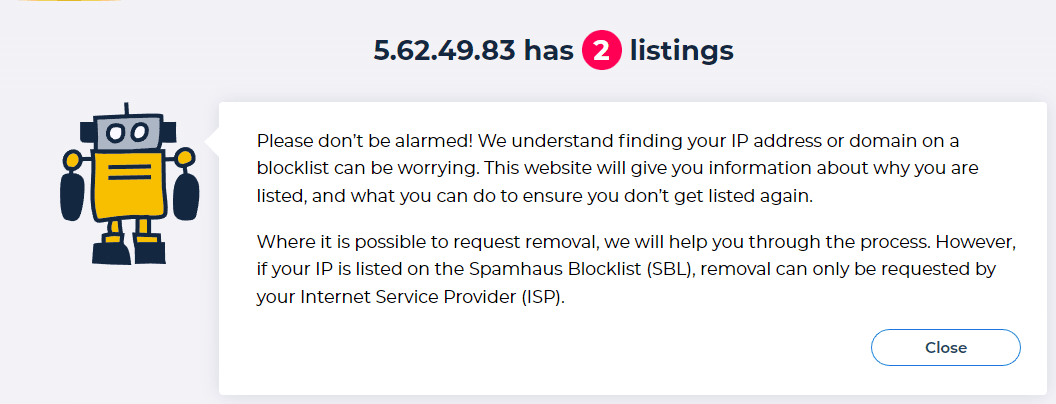
After exploring the website and gathering information, you'll find the feature you need. Select the checkbox to acknowledge the warning and click Next Steps.
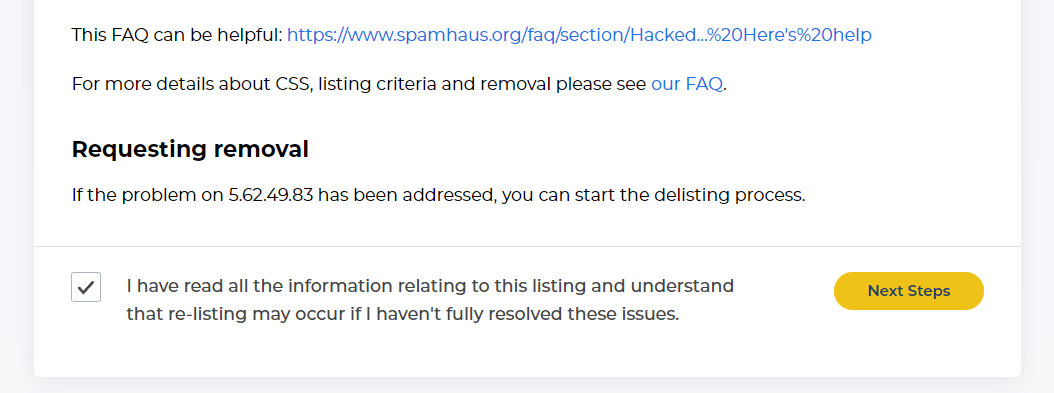
Complete and submit the form.
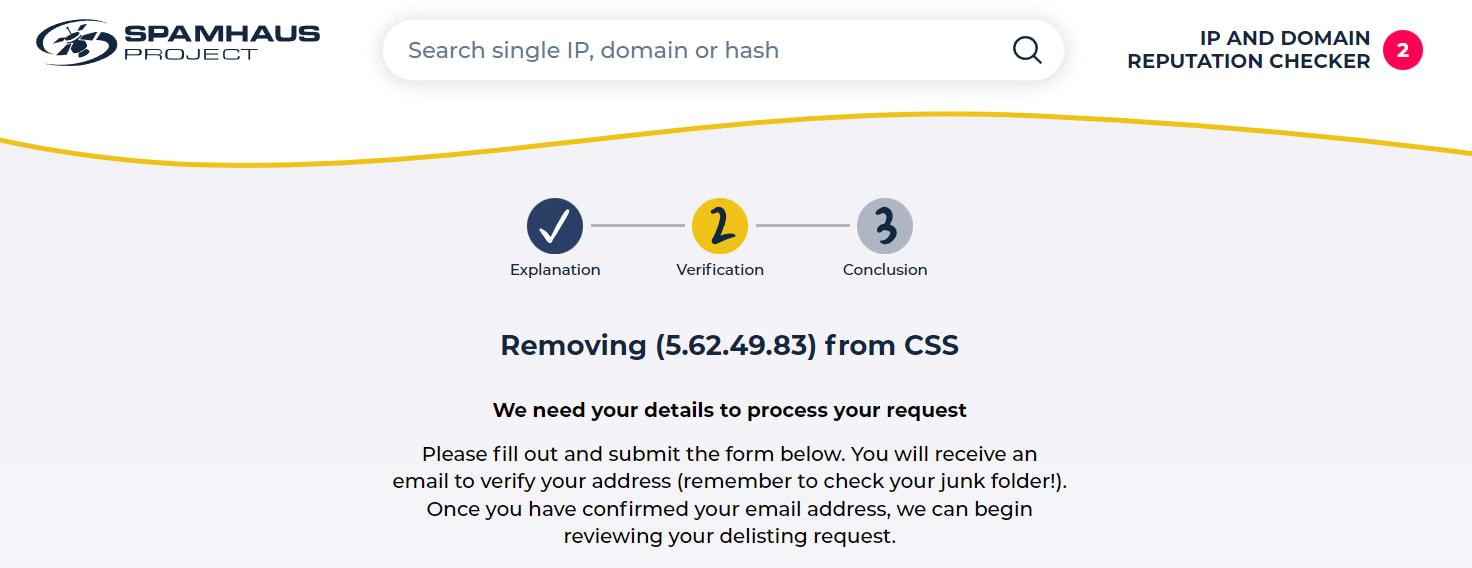
This procedure is similar for the other blacklists, making it easy for you to remove your IP address.
Conclusion
There's no need to worry about mistakenly ending up on a spammer blacklist if you adhere to basic online safety rules and don't engage in wrongdoing. The likelihood of being accidentally added to such a database is quite low. However, if it does happen, remember that you can always reach out to your hosting provider's support team for how to remove yourself from blacklist.
Choosing a high-quality hosting service for your website is crucial. If you're still searching for one or considering switching from your current host, Liquid Web’s Managed Hosting solutions are a great place to start. Contact the sales team to discuss your needs and find the best solution.
Related Articles:

About the Author: Zachary Armstrong
Zachary is a writer who specializes in breaking down complex subjects and making them easy to understand. He has a passion for technology, believes it can change the world for the better, and wants to tell the whole world about it.
Our Sales and Support teams are available 24 hours by phone or e-mail to assist.
Latest Articles
How to install Puppet Server on Linux (AlmaLinux)
Read ArticleDeploying web applications with NGINX HTTP Server
Read ArticleEmail security best practices for using SPF, DKIM, and DMARC
Read ArticleLinux dos2unix command syntax — removing hidden Windows characters from files
Read ArticleChange cPanel password from WebHost Manager (WHM)
Read Article


